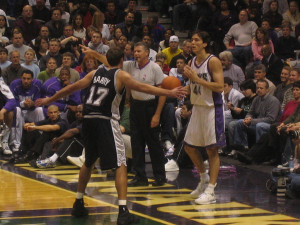Quick Inbounding Helps Teams be Better

The Inbounding the ball following a score by an opponent is a very crucial time, but this situation is not widely discussed or focused upon. Many teams fail to discuss the activity of inbounding the ball for lack of awareness about how pivotal or technical this activity is.
Inbounding the ball quickly makes a number of good things happen for a team. The first of which is it provides an opportunity to relieve pressure upon the receiver by accelerating the offense prior to the defence being set and ready to go. Most defences require at least some initial lead in time to be set and get ready to go. This is especially true for those defensive strategies that involve trapping.
Secondly, by quickly inbounding the ball the offensive team is forced to move into their transition quicker. Offensive players as a result will also have to be sharper in the set-up of their positions at the start of transition. This will result in players sprinting to positions and being more reactive in the time while the ball is with the inbounder.
Additionally from time to time a quick inbound of the ball will result in a team starting a fast break phase of play. This might be out of broken play or from transition offense that leads to a player advantage situation. Nevertheless, in every game, these scenarios do present, and if an offensive team becomes quick and proficient enough the number of these situations will increase throughout each and every game.
The technique for inbounding the ball quickly will take practice and a mindset by both the coach and players of attention to detail is needed. Only through establishing the practice of inbounding the ball quickly and making this a habit that is constantly reinforced, will individuals and the team as a whole start to see this as a way of life rather than a novelty exercise.
The rebounder must pull the ball out of the net; this means the rebounder/inbounder must jump and catch the ball above their head moving towards the baseline. The inbounder must not wait for the ball to drop into their hands and then move, the player must be moving as they catch the ball towards the baseline.
Receiver must communicate where they are; by communicating with the inbounder as the player is moving to the baseline the receiver can help make the pass quicker.
Footwork out of bounds; the inbounder must limit the time the ball is in their hands. To do this the inbounder should look to get both feet out of bounds as soon as possible. Running over the baseline will be quicker than jumping over the line because when running the inbounder can start to turn to face up the court once one foot is planted. A point of caution should be noted about inbounders not looking to get both feet out of bounds. It is a poor habit to step over the baseline with one foot but never commit to moving both feet out of bounds.
The pass must be made following eye contact with the receiver; too often players can become complacent and not keep the fundamentals of passing strong. Only when vision is established should the pass be initiated.
Inbounding the ball quickly should not compromise a good standard of play and execution. The philosophy behind inbounding the ball quickly is that the team must rise to the challenge of playing with a purposeful pace. If the play deteriorates as a result of the speed from this exercise then focus on the play from one of the floor to the other, at all costs do not slow down the inbound.




